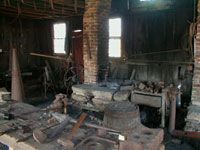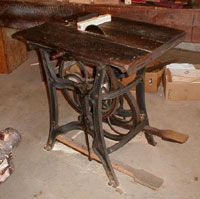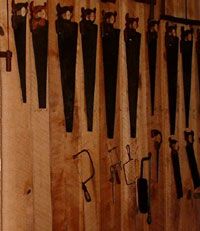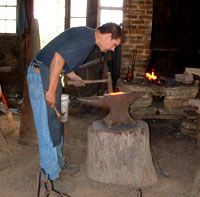

 In the early 1960's J. Edmund Bull converted his tool collection into a museum at his home that he named Steppingstone. The collection was begun perhaps 20 years before around his grandfather's tools. A group of like-minded people began to help demonstrate, describe and even collect, and became known as the Steppingstone Association. In 1968, Steppingstone Museum Trust of Harford County, Maryland, Incorporated (a real mouthful) received the entire Ed Bull collection. At that time, there were about 7,000 artifacts and there have been well over 5,000 donations since. The Museum was moved to its present location in 1978 after Mr. Bull's death.
In the early 1960's J. Edmund Bull converted his tool collection into a museum at his home that he named Steppingstone. The collection was begun perhaps 20 years before around his grandfather's tools. A group of like-minded people began to help demonstrate, describe and even collect, and became known as the Steppingstone Association. In 1968, Steppingstone Museum Trust of Harford County, Maryland, Incorporated (a real mouthful) received the entire Ed Bull collection. At that time, there were about 7,000 artifacts and there have been well over 5,000 donations since. The Museum was moved to its present location in 1978 after Mr. Bull's death.
Steppingstone Museum is now housed on the Land of Promise Farm that was founded in 1771 and is now part of Susquehanna State Park. We are located north of Havre de Grace, Maryland and just two miles off Interstate I-95. Housed in the four original farm buildings, two newly constructed buildings and a donated blacksmith shop, Steppingstone Museum is operated by volunteers and has hosted tens of thousands of visitors. Intended to preserve and display the technology of 1870 through the 1920's, Steppingstone Museum invites you to take a "Step Back in Time".
 The trades that are on display include Potter, Decoy Carver, Wheelwright, Farmer, Blacksmith and Woodworker. With the exception of farmer, which is represented throughout the Museum, each trade has a working shop brought to life by volunteer craftspeople who demonstrate and teach. The Foard Blacksmith Shop was a working blacksmith and farrier shop for 97 years, until the 1981 death of the last blacksmith in the family. The surviving family donated the entire shop to the Museum in 1981 and it was trucked to the Museum in 1983, stack, forge and anvil.
The trades that are on display include Potter, Decoy Carver, Wheelwright, Farmer, Blacksmith and Woodworker. With the exception of farmer, which is represented throughout the Museum, each trade has a working shop brought to life by volunteer craftspeople who demonstrate and teach. The Foard Blacksmith Shop was a working blacksmith and farrier shop for 97 years, until the 1981 death of the last blacksmith in the family. The surviving family donated the entire shop to the Museum in 1981 and it was trucked to the Museum in 1983, stack, forge and anvil.
Although more of a business than a craft, the commercial canning of tomatoes had been a major industry in Harford County until the 1990's, when the last of about 100 canneries closed. Steppingstone's Cannery Committee recently completed a dedicated building and display of the process and artifacts of commercial tomato canning. Did you know cans used to be soldered shut with lead solder?
 Volunteers are evolving our Woodworking Shop from a static display of artifacts into a shop that is capable of supporting the work of a rural Woodwright, a Jointer and a Cabinetmaker. Historically speaking, of course, the trades would never have existed in a single shop, nor would some of these trades have had so many draw knives on the wall. We are trying to balance the display of the many artifacts in the collection with the layout effect of a working shop. It is certainly easier and more fun to teach and demonstrate in the atmosphere of a working shop, too.
Volunteers are evolving our Woodworking Shop from a static display of artifacts into a shop that is capable of supporting the work of a rural Woodwright, a Jointer and a Cabinetmaker. Historically speaking, of course, the trades would never have existed in a single shop, nor would some of these trades have had so many draw knives on the wall. We are trying to balance the display of the many artifacts in the collection with the layout effect of a working shop. It is certainly easier and more fun to teach and demonstrate in the atmosphere of a working shop, too.
 On display in the Woodworking Shop are floor tools from the 1870's, including a foot-pedaled crankshaft lathe patented in 1876, a pedal-powered table saw from 1894 and a pedal-powered scroll saw with patent dates from 1876 to 1904. The lathe is an extremely popular tool with our volunteers, allowing the turner to sit down, get healthful exercise while working at a quiet, efficient machine, and no electric bill. The table saw is unusual among our foot-powered tools since it requires three people to operate it - a shop Master or Journeyman to direct the wood and the two husky apprentices (or some gullible hangers-on) who provide the power. The effort and noise makes it unpopular with the woodworkers and earned it the nickname of "The Monster". The visitors, on the other hand, seem to find the thing absolutely fascinating and we have no trouble getting volunteers to power it for short demonstrations. We use 1 x 2 pine for a warm-up and then offer a piece of oak. We get very few takers, and after the first time even fewer repeats. The scrollsaw, on the other hand, has a 21-inch throat, a huge table of cherry, is quiet, efficient and capable of working stock from veneer to full 5/4 stock. It was named "Beauty" by a student, for obvious reasons.
On display in the Woodworking Shop are floor tools from the 1870's, including a foot-pedaled crankshaft lathe patented in 1876, a pedal-powered table saw from 1894 and a pedal-powered scroll saw with patent dates from 1876 to 1904. The lathe is an extremely popular tool with our volunteers, allowing the turner to sit down, get healthful exercise while working at a quiet, efficient machine, and no electric bill. The table saw is unusual among our foot-powered tools since it requires three people to operate it - a shop Master or Journeyman to direct the wood and the two husky apprentices (or some gullible hangers-on) who provide the power. The effort and noise makes it unpopular with the woodworkers and earned it the nickname of "The Monster". The visitors, on the other hand, seem to find the thing absolutely fascinating and we have no trouble getting volunteers to power it for short demonstrations. We use 1 x 2 pine for a warm-up and then offer a piece of oak. We get very few takers, and after the first time even fewer repeats. The scrollsaw, on the other hand, has a 21-inch throat, a huge table of cherry, is quiet, efficient and capable of working stock from veneer to full 5/4 stock. It was named "Beauty" by a student, for obvious reasons.
The collection has an amazing variety of bench planes from 6-inch coffin-shaped razeed-bodied smooth planes through jacks, foreplanes, to 32-inch jointers. We are fortunate to have a wide selection of molding planes for the cabinetmaker and jointer as well as the sash filletsters and sash planes for the window maker. Our planes originated from Baltimore to New England and Ohio, dating from the 1840's through the early years of the twentieth century. Unfortunately, some of them haven't been given the care and respect they are due, but someone had the foresight to hold on to them instead of feeding the woodstove. We have those artifacts to demonstrate the effects of neglect and abuse. On the other hand, it is quite a privilege to get to work with tools that may have had three workmen (as witnessed by the names and initials stamped in them) owning and using them before they come into our care.
 The rest of the collection is hand-powered except for a ¼-inch electric drill patented in 1917 that was donated by Black & Decker in 2002, which is headquartered 30 miles away. With the vast majority of our augers and drills being cordless (and strictly muscle- powered), we have no problems with outlets, extension cords, dead batteries or noise. In fact, we tell our visitors and students that our definition of a power tool is "an exceedingly sharp edge directed by a well-trained mind." You may rest assured that we were Y2K ready, well in advance!
The rest of the collection is hand-powered except for a ¼-inch electric drill patented in 1917 that was donated by Black & Decker in 2002, which is headquartered 30 miles away. With the vast majority of our augers and drills being cordless (and strictly muscle- powered), we have no problems with outlets, extension cords, dead batteries or noise. In fact, we tell our visitors and students that our definition of a power tool is "an exceedingly sharp edge directed by a well-trained mind." You may rest assured that we were Y2K ready, well in advance!
Steppingstone has a lathe collection that is expanding to include the 1876 pedaled lathe, a salesman's sample, a recently donated treadle lathe (shop-made and dating to about 1916) and two commercial-sized monsters that will require a separate power source. As time and volunteer-power permit, these tools are going to be brought to full working condition and, hopefully, used for demonstrations. Other tools that are being displayed are T-handled augers, braces of many descriptions and the tools for felling, bucking and hewing a tree into a beam. We hope to complete a display showing the entire process and tools very soon.
Display and demonstration is only part of the volunteer activities. Behind the scenes, the collection is being cataloged to Smithsonian Institution standards in a project that was begun in 1993 and has been continuing like Star Trek, ever since. As the people-power permits, and donations continue, this looks like a never-ending project. For anyone who loves old tools (and other things as well) and enjoys a detective story, cataloging is great. However, it is painstaking and can require an hour even for a simple plane with just a stock, wedge and iron. We also perform our conservation and restoration while the Museum is closed for the winter. One very good reason for this is the lack of heat in many of our display buildings. You can imagine how cold it can be at our Holiday Open House in December. Let's hear it for Global Warming, so we can be open more of the year!
 Our volunteers are here to be around the collection and to share their knowledge and skills. They teach what they know by demonstration and the Apprentice system. For an organization that is only open to the public on weekends from May through September, a true apprenticeship program is impossible, but we try. We teach one-on-one and try to get our visitors hands-on, whenever possible, to literally give them a feel for the trade. Favorites seem to include the shaving horse and draw knife, learning to plane a board, and using some of our augers and brace and bit combinations. Steppingstone also has volunteers who come in on weekdays to host school groups and special tours. In addition, we send craftspeople to elementary schools in Harford County to demonstrate crafts for the 4th graders who are studying colonial history. Things really didn't change all that much between 1700 and the 1920's.
Our volunteers are here to be around the collection and to share their knowledge and skills. They teach what they know by demonstration and the Apprentice system. For an organization that is only open to the public on weekends from May through September, a true apprenticeship program is impossible, but we try. We teach one-on-one and try to get our visitors hands-on, whenever possible, to literally give them a feel for the trade. Favorites seem to include the shaving horse and draw knife, learning to plane a board, and using some of our augers and brace and bit combinations. Steppingstone also has volunteers who come in on weekdays to host school groups and special tours. In addition, we send craftspeople to elementary schools in Harford County to demonstrate crafts for the 4th graders who are studying colonial history. Things really didn't change all that much between 1700 and the 1920's.
Highland Hardware has provided support by sending us a dozen catalogs every Spring so that we can prove to our visitors that the tools they see on display are still being made, sold, bought and used. All too often we hear how these trades are dead and this makes our denials much more believable. You can get more information on Steppingstone Museum from our website,
www.steppingstonemuseum.org
. We hope to see you soon and you can reach us through the web site. We do organize special group tours to let you peek behind the scenes and provide more personal attention to your interests.
Steppingstone Museum does not purchase artifacts, but does accept donations. We ask that they be of reasonable condition (ideally in usable condition!) to represent the type of artifact. You will be asked to fill out forms to provide any information that you have for inclusion in our cataloging effort. Donations can be arranged by contacting the Museum through our website or at steppingstonemuseum@msn.com .
Steppingstone Museum
461 Quaker Bottom Rd.
Havre de Grace, Maryland 21078
Phone: 410-939-2299
Toll-Free: 888-419-1762